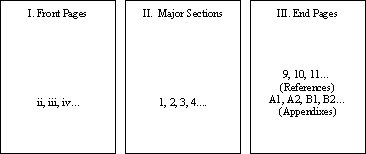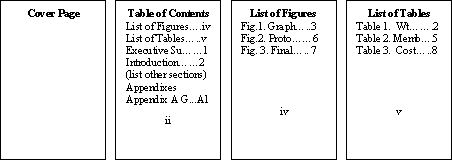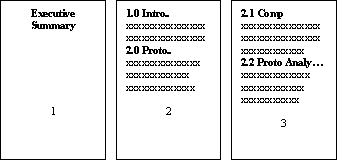
Due Date on web site
ENGR 100 - Final Bridge Report (20%)
Your team is responsible for composing a single final report that describes in detail your bridge design. The audience of this report is the instructor and the tone should be formal. The purpose for writing this report is to document the design and performance of your prototype and final bridge.
Report Format
The technical report should be a professional document. Graphs, tables, and drawings should be used to clarify the text. The three main parts of a technical report are shown below in Figure 1:

Figure 1. Three Main Sections of a Final Report
I. FRONT PAGES
The front pages include the Cover Page, Table of Contents, List of Figures, and List of Tables. The page numbers are Roman (e.g., i, ii, iii, etc.) and there are no numbers on the cover page (although it is considered the first page).
The first page of the technical report should be unnumbered and includes the name of the report, team name, names of all group members, your affiliation (i.e., ENGR 100, Section B), and the date. Each item should be centered and separated by enough space to fill the whole page and give the cover page a good appearance.
This is a listing of the major sections in the report and the page numbers on which they begin. The table of contents does not list itself but includes the page numbers of the pages that appear in the front of the report, major sections, and appendixes.
This is a list of all of the figures in your report and the page numbers on which they are found. Do not include this section unless you have at least three figures in your report.
This is a list of all of the tables in your report and the page numbers on which they are found. Do not include this section unless you have at least three tables in your report.
The following is a sample of the front pages (Figure 2):

Figure 2. Sample Front Pages
II. MAJOR SECTIONS
This is the main part of the report. The page numbers begin with one and are numbered in Arabic (e.g., 1, 2, 3, 4, etc.). After the executive summary, each major section should be numbered and titled as shown in Figure 3 below:

Figure 3. Sample Major Sections
To introduce each new section, use a header (e.g. "1.0 Introduction") and an introductory sentence explaining what this section will be about. Suggestions for the contents of your team's bridge report are as follows:
Executive Summary
The executive summary is a report summary which includes information from each section of the report. The purpose of the executive summary is to allow the reader to learn the major ideas and findings without having to read the whole report. Generally an executive summary is written after the report is finished and is approximately 10% in length compared to the whole report (i.e. 1 page long for a 10 page report).
1.0 Introduction
This section briefly lays out the project and the requirements (i.e., the problem definition and constraints). It also identifies the goals of the report and what types of information are included in the report.
2.0 Prototype Testing
This section describes the analysis leading to the final design. It emphasizes the design process based on theory, testing, and good engineering reasoning. This section might be organized as follows:
2.1 Component Analysis
Here, give a short summary (approx. one paragraph) of the results from the relevant component tests.
2.2 Prototype Analysis
In this subsection, describe how your team made the decision to build the prototype that you did. Describe or show at least three design ideas your team considered early in the process. Then explain what criteria was important (bridge weight, strength, ease of construction, etc.) and why your final prototype was the best choice. If you used West Point Bridge Designer Software to help in the design process, include details in this section too.
2.3 Prototype Performance
Present the results of the prototype test including the score (wt. held/wt. of bridge). How did your bridge perform during the test? Where did it fail (use arrows to show in pictures)? Identify parts of the bridge that were very strong and others that were weak.
3.0 Final Design
This section justifies the final design. The idea is to defend key features of the final design based on the results of Section 2 (Prototype Testing). This section might include the following:
3.1 Revision and Final Design Construction
This section describes your final bridge design. Here, you should discuss the factors that entered into your revised design. Use drawings to fully describe your final bridge design layout. Present enough detail so that the reader can clearly see the difference between the prototype and the final design (side by side pictures are often helpful).
3.2 Final Design Performance
Briefly describe the performance of your final bridge. Report the score and describe whether the improvements you included during the redesign performed as planned.
4.0 Conclusions and Recommendations
Support the purpose identified in the introduction by pulling together the results and findings from previous sections of the report. Emphasize the major points you feel are important. Discuss recommendations for improving the final design. This section should be a brief, bottom-line summary and not include any new information not already discussed in detail in the report.
III. END PAGES
The end pages include the references and appendixes.
If you used any outside resources and mentioned them in this report, compile a list of references. Referencing should follow a format like you may encounter in your textbooks.
In Appendix A, Team Member Contributions, list your team members and contributions (identify specific sections each person wrote or edited and project tasks completed). Create additional appendixes as needed. See Figure 4 for a sample:

Figure 4. Sample End Pages
Grading
The grading of the assignment will follow the evaluation table given below:
|
Evaluation Criteria |
Pts |
Score |
Comments |
|
Format |
20 |
Is the report format correct and professional? Are there any mistakes in the tables or figures? Are the Tables and Figures labeled correctly and referred to by name in the text? |
|
Introduction |
10 |
Is the most important report information highlighted in the executive summary? Does the introduction describe a clear report purpose? |
|
| Content: | 35 | Is any information missing? Are the findings and statements accurate? Are the ideas fully developed? Are pictures placed effectively to explain text? | |
| Conclusion | 5 | Does the conclusion address the main points? | |
| Transitions |
4 |
Are clear transitions used between sections and ideas? |
|
|
Writing Style |
20 |
Is the report carefully proofread (minimal errors in spelling, grammar, punctuation, etc.)? Is the writing concise and tone formal? |
|
| Appendix | 6 | Individual Contribution | |
|
TOTAL |
100 |
|